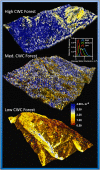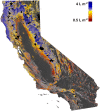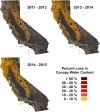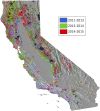Progressive forest canopy water loss during the 2012-2015 California drought
- PMID: 26712020
- PMCID: PMC4720336
- DOI: 10.1073/pnas.1523397113
Progressive forest canopy water loss during the 2012-2015 California drought
Abstract
The 2012-2015 drought has left California with severely reduced snowpack, soil moisture, ground water, and reservoir stocks, but the impact of this estimated millennial-scale event on forest health is unknown. We used airborne laser-guided spectroscopy and satellite-based models to assess losses in canopy water content of California's forests between 2011 and 2015. Approximately 10.6 million ha of forest containing up to 888 million large trees experienced measurable loss in canopy water content during this drought period. Severe canopy water losses of greater than 30% occurred over 1 million ha, affecting up to 58 million large trees. Our measurements exclude forests affected by fire between 2011 and 2015. If drought conditions continue or reoccur, even with temporary reprieves such as El Niño, we predict substantial future forest change.
Keywords: canopy water; climate change; drought; forest health; imaging spectroscopy.
Conflict of interest statement
The authors declare no conflict of interest.
Figures






References
-
- Robeson SM. Revisiting the recent California drought as an extreme value. Geophys Res Lett. 2015;42(16):6771–6779.
-
- Brown EG. State of California Proclamation of a State of Emergency. Executive Department, State of California; Sacramento, CA: 2015.
-
- Williams AP, et al. 2015. Contribution of anthropogenic warming to California drought during 2012-2014. Geophys Res Lett, 42(16):6819–6828.
-
- Allen CD, et al. A global overview of drought and heat-induced tree mortality reveals emerging climate change risks for forests. For Ecol Manage. 2010;259(4):660–684.
Publication types
MeSH terms
Substances
LinkOut - more resources
Full Text Sources
Other Literature Sources

